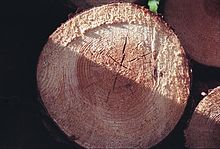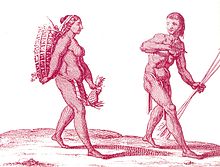AP Environmental Science/Introduction
BACK TO AP Environmental Science
Environmental Science vs. Ecology
[edit | edit source]
Environmental science deals with the relations between us (humans) and the living habitat we reside in (Earth), while ecology, a subset of biology, deals with a separate living organism and its environment (a bird and its nest).
Frontier science vs. Consensus science
[edit | edit source]Frontier science is a heavily-debated, controversial science which has, for the most part, not been tested/confirmed through tests by scientists who are considered experts on the field. Sources mainly originate from new reports (since frontier science is "news-worthy") about "scientific breakthroughs" and disagreements relating to the validity of various hypotheses. Consensus science consists of well-approved, through the process of peer-editing, data, theories, and hypotheses by scientists who are experts in the given field.
Limitations of Environmental Science
[edit | edit source]

A lot of limitations exist in this well-intent science:
- Validity of Data
- Measuring topsoil (loss of topsoil) and topography--hard to measure.
- Number of species endangered by extinction--do we really know if EVERY animal of that given species is really gone?
- Hectares of rainforest being cut off--a measure/marker has to already be put in the given hectare of rainforest in order to be tested.
- Tons of pollutants in the atmosphere/water--an example of pollutants in the atmosphere: Carbon dioxide from cars. Do we really know how much carbon dioxide every car emits into the atmosphere? Does every car work differently or the same? (btw, differently, so we don't know how much carbon dioxide is emitted by every car since every car is different and it is tedious to measure each and every car's emission of carbon dioxide).
- Complex Environmental Systems
- Climate Change
- Global Warming
- In terms of the universe as the universe is constantly expanding
Also, well-known scientists stating contrary opinions (evolution).
Natural Resources vs. Natural Services
[edit | edit source]
Natural resources are resources, on a human scale, are anything obtained from the environment in order to satisfy human needs and wants, such as air, water, soil, land, life (biochemistry), iron and sand. Some natural resources are nonrenewable, meaning it is in a fixed supply (such as coal, iron, sand, etc.). Renewable natural resources are resources that are replenished rapidly (in a matter of hours or several decades), such as trees, crops, and animals. Perpetual natural resources are resources that never go away/continuous, such as wind and sunlight.

A natural service, otherwise known as an ecological service, is a natural biological process that benefits the human beings, such air/water purification, soil renewal, nutrient recycling, food production, pollination, grassland/forest renewal, waste treatment and climate/population (species interaction)/pest control. Ecological services are divided into 4 categories:
- Provisioning services: The products/resources produced by nature, such as food (wheat) and wood.
- Supporting services: Products of nature that help sustain life (nutrient cycling).
- Regulating services: Services that maintain different aspects of the Earth, like pollination and carbon storage.
- Cultural services: Services that serve as a form of knowledge, recreation, spiritual enrichment, etc. An example is a huge, grassy field intended for sports (football).
Major Cultural Changes and Resource Use
[edit | edit source]
- Primitive culture - Hunter-gatherers (low impact on ecosystems)
- 12,000 ya - Agricultural Revolution; domesticated crops and live stocks (high impact on ecosystems)
- 275 ya - Industrial (and medical) Revolution; movement from renewable energy (wood) to non-renewable energy (coal), as non-renewable energy is more efficient and faster.
- 50 ya - Information/Technology Revolution (lower impact).
Sustainability and Tragedy of the Commons
[edit | edit source]- Sustainability is utilizing a renewable resource at a rate that it can be replenished naturally without it being decreased. It is also using a non-renewable resource as efficiently as possible, such as coal.
- Tragedy of the Commons is a mindset relating to the use, or conversation, of shared resources. An example of this is in the UK (England, Scotland) where people, who used a common land, would exploit the land so much (by adding extra livestock), causing the shared resource (grass) to be unusable. The typical tragedy of the commons attitudes is like "if I don't use it, someone will" (Chick-fil-A; people taking more than they need) and "what I do really won't matter" (littering).
Ecological Footprint
[edit | edit source]Ecological Footprint is used to describe the human impact on the environment in terms of the measurement (hectares) of biologically productive land and water that is orchestrated to aid an area with resources and to absorb the wastes generated from the resources. The US manages to exceed their biocapacity as we use 25% of the global ecological capacity. The per capita ecological footprint for the US is 9.7 hectares of land (World Wide Fund for Nature).
Biodiversity
[edit | edit source]
Biodiversity (life) is composed of:
- Species Diversity (variety of different species)
- Genetic Diversity (variability within individual species)
- Ecological Diversity (variety of ecosystems)
- Functional Diversity (such as energy flow/matter cycling)
Pollutants
[edit | edit source]
A pollutant is a harmful substance that contaminates, such as trash in the water. Two types of pollutants exist. Point-pollutant is pollution which can easily be identified and easily managed. We can look at emissions (create air pollution) from factories and effluents (create water pollution, such as liquid waste), such as sewage pipes in a river. Nonpoint-pollutant is pollution that cannot be easily identified and managed as it is difficult to trace, identify, and control. An example of this is runoffs (fertilizers, oils from cars, etc.).
Persistance of Pollutants
[edit | edit source]- Not persistent
- Degradable: Broken down or reduced to acceptable levels by natural, physical, chemical, or biological processes.
- Biodegradable: Complex pollutants that can be broken down by living organisms, such as bacteria and sewages.
- Persistent
- Slowly degradable: Takes decades or longer to degrade, like insecticides, DDT (nearly ran bald eagles exist by contaminating the fish they ate) and most plastics.
- Nondegradable: Chemicals that natural processes cannot break down, such as lead and mercury.
